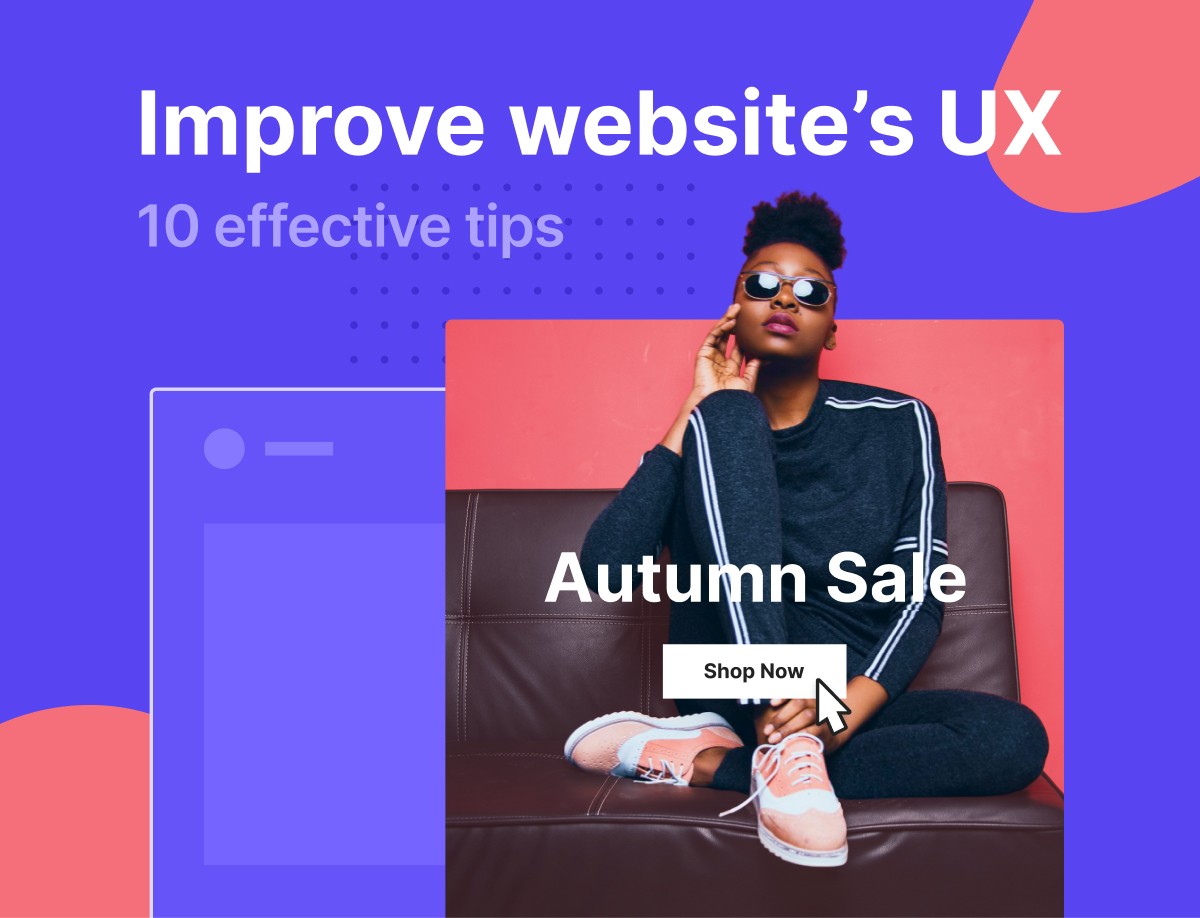Your website can be the most powerful marketing tool at your disposal. It is your salesman 24/7, and as such, could be your most powerful asset and a centrepiece of your marketing efforts.
A business’ website or app can leave a lasting impression on a customer — and whether that impression is good or bad can depend on many factors.
Getting the User Experience of your website or mobile app right can help uplift your business in more ways than you can imagine. And contrary to what you might think, the UX experience of your website is a major game changer.
As observed by a web design agency, digital trends that are rapidly evolving can make your website feel old and outdated. While a redesign may be desirable sometimes, you may not have the time or resources to invest in such a massive project. To help you overcome this challenge, we’ve put together a list of 10 simple ways you can improve your user experience design to make it more helpful and useful.
What Is UX Design?
User Experience Design (UX Design) is the process of increasing user satisfaction (for apps and websites) by improving the usability, accessibility, and efficiency of user interaction with the website or apps. The point is that UX Design helps in making a website or application that you build easy to use, and not confusing for users.
UX design focuses on your consumers’ experience of using your product. The “product” goes beyond the physical good or service you sell — it involves the content you produce to reach your consumers and connect with them before they have even touched your products.
The aim when developing a website with the user experience in mind is to escort your visitors around your company in a way that tells them exactly what you want them to see and understand at particular points in their navigation process.
When approaching a physical product’s user experience, the aim is to deliver a specific solution that corresponds to the user’s needs at that time. If the user’s needs change, the product may then provide a new solution. Adobe has a series of tools for UI/UX designers, like Adobe Color, Adobe XD, etc. that work with cloud apps and offer all the features in one place.
What UX Designers Do Goes Beyond UI Design
“User Experience Design” is often used interchangeably with words such as “User Interface Design” and “Usability.” However, while usability and user interface (UI) design are essential elements of UX design; they are subsets of it. UX design often encompasses a wide variety of other fields.
A UX designer is concerned with the entire process of product acquisition and integration, including branding, architecture, usability, and functional aspects. It starts before the products are even in possession of the user.
Thus, products that have great user experience (for example, the iPhone) are designed with not just the use or consumption of the product in mind, but also the process of purchase, ownership, and even troubleshooting.
Similarly, UX designers are not only focused on developing functional products; they are also focused on other aspects of the user experience, such as pleasure, efficiency, and fun. As a consequence, no single concept of a good user experience exists. Instead, successful user experience is one that meets the needs of a specific user in a particular sense where he or she uses the product.
How to Enhance site User Experience Design
1. Everything Begins With User Research
Before you begin designing product experiences, you may be tempted to start with the question: “what exactly will it do?” However, you might just be getting ahead of yourself. In the context of UX, no question matters more than, “Who is it for?”
That’s where you start the design of your user interface. You need to know who will use your app (and anyone else who might be in your audience) long before you sit down to draw things out. What would they like? Are their needs being met? What can your mobile app give them that they don’t get somewhere else? What would you do better than your competition if they get it elsewhere?
(Hint: if you offer a better user experience, that’s a serious competitive advantage.)
This doesn’t mean that you have to spend thousands of dollars on market research and analysis. Find out who your target audience is, first. If you are creating a mobile experience to complement an existing one, such as a web application or a retail experience with brick and mortar, then this part is simple for you, since you already know and can survey your (current) users.
If you’re creating a mobile app or webpage you can find your target audience persona by asking questions such as:
- What demographic features are you targeting? Women 19–28, men and women over 50, or maybe professionals, students, parents, etc.?
- What interests are you targeting? Gamers, volunteers, fashionistas, foodies, musicians, travelers?
- What products, apps, or services are they already using? What reviews on app stores and social media are they giving such goods and services? How do these creators respond, and what can you do better?

Your UX design process should be based on all these information. To learn as much about your target audiences and what they need as possible, use polling, surveys, statistics, and even good old fashioned Google. Remember: it’s a lot easier to build experiences that people want than to make people want experiences that you have created. So, brace yourself to become a stalker:) By creating a sense of visual hierarchy, white space helps to guide users through a website and draw their attention to the most important information,” says Milosz Krasinski.
2. Simplicity- Keep It Simple and Practice Responsive Design
In a website layout, simplicity essentially means getting rid of unnecessary components in a design. Note that you want a particular action to be taken by a visitor coming to your site. In order to get what they have come to search, they will scan the content. It’s important to remember that if they have to navigate a maze to find what they want, they won’t hang around. This is why it’s imperative you get timely and contextual feedback on your UI elements as you build it. It not only helps you get better feedback but also makes sure you’re on the right track.
Simplicity entails having a clean layout, a two or three-color scheme and plenty of white space, an average of two fonts, and the third one for your logo. Your graphics must have a purpose; to be both clickable and insightful.

GIF Source Tenor.com
- Every page should have a single definite goal. The checkout page, for instance, contains only what is needed for the process of checkout. Only contact information and/or a form are included in the contact list, not tips on personal-grooming habits.
- The intent of each page and each item on it is immediately understandable, without clarification, by the user. For instance, the user interface has visually distinct (more on that later) navigational elements on the page.
- Any additional but unimportant data goes to the bottom of the list. For example, with “you might also like” content,or the extra blogroll at the bottom of the post.
3. Whitespace Is Your Friend – Use It Generously
This is one of the quickest and easiest ways to enhance your design. Even subtle amounts of whitespace will allow your designs to breathe and look more polished.
The design background color does not always have to be white. It only needs to be the space between elements of the website. White space adds simplicity and elegance to your web pages.
Here are some ways you might use white space to boost the UX of your website:
- Increase the line space for your text in the body
- Increase white space in long text blocks on the left and right margins.it’s been shown to improve comprehension up to 20%!
- Avoid putting images in line with text instead of positioning them on top or under text blocks.
- Group and surrounding related objects with white space
4. Make Different Elements Visually Distinct
One of the most significant goals for UX designers is a visually distinct page layout. It is a way to retain a flexible user path and engaging user experience.
Long story short: make it easy for your users to find whatever they are looking for on your pages with minimum fuss.
Additionally, make your website/app navigation visibly distinct.
Here are a few tips that might be useful during the design process:
- The most important details on the website ought to stand out the most. If it’s a blog post, you need a clear-cut headline like “Best trends in web design,” followed by subtitles and subheadings that dig deeper into the subject.
- Users must be aware of their location on the mobile app or website. There must be navigational tools at hand. For instance, at the top of the page, you have a website navigation panel with all the important parts of the website easily accessible.
- Call-to-action buttons need to stand out and provide a concise explanation of their intent. They should be readable and accessible. A subscribe icon, for instance, with a field to type in your email.
- The search field must be visually distinct with, preferably, the placeholder text “search” together with a glass icon. It’s usually at the upper right corner of a website.
- Contrast and Color: text readability and eye-friendly design are important. The readability of the text depends significantly on the colors you use and the contrast between your text color and the surroundings.
There are several tools, such as Usecontrast and Colorsafe, that will help you check the adequacy of the colors and contrast you use. Make sure color-blind users can read your website and be conscious of the contrast or general color of the mobile website.
And when it comes to colors, it’s important to be aware that:
- Generally, background colors are muted
- Blue is for text links
- Red is for important items, usually warnings or mistakes.
- Calls to action require a strongly contrasting hue that stands out from the rest.
5. Ask for Customer Feedback
Successful businesses and marketers listen to what their customers say – you should, too. If you don’t you are setting yourself up to lose out on an opportunity to better your products.
On your website, you could add a survey that asks customers to rate their experience.
Ask questions like:
- In order to enhance your experience, what should we do?
- Which features would you like to see in the future?
- Did we meet your expectations?
These questions allow individuals to explicitly tell you what they want to see on your website. You should collect the outcomes and evaluate them, searching for trends. For instance, if 70 % of respondents claim they have a problem finding specific posts on your website, this could mean that it is time to add a search feature.
Listening to input from customers and making appropriate changes allows you to improve your UX significantly.
6. Flow: Maintain Consistency of the User Flow Throughout the Journey
In terms of design, flow is when the user moves effortlessly from one aspect of the website or mobile app to another to fulfill the ultimate objective of fulfilling their goals.
Here’s why it matters: a clear design framework allows consumers to get what they want seamlessly. That works to your advantage. Consistency perpetuates implementation.
You need to think through what the user is going to do step by step to keep things consistent.
Let’s take the flow of a website, for example. At an entry point, usually the homepage or a blog post, the user starts their journey.
You need to think about where the point of entry would lead. For instance, it may lead to another blog post that expands on the topic or a website that provides another service or product that meets the needs of the user.
Dead-end pages are another thing to consider; those pages that don’t lead anywhere else. You need to avoid such instances throughout the user journey when possible. Every page on your website ought to lead somewhere.
Finally, each website flow has an end target, where the needs of users and the goals of your website meet. For example, if users are searching for valuable content and you are providing valuable content, then a subscribe button or Patreon link is a reasonable end goal.
7. Page Loading Time
Your website’s loading page speed is very imperative. If it takes longer than 3 seconds to load, 53 percent of people will leave your app.
Make sure that website users can quickly and easily accomplish their primary goals, without having to wait for your website to take forever to load. The load time, waiting times, and smoothness of popup animations could affect the perception of users.
8. Focus on Content
A designer’s job should not only end with well-structured layouts. Do not forget about UX writing. Work in a team and demand quality material. Use the language that your users are familiar with, be user-oriented; make sure that your contact with the user is transparent. Also, a sense of humor is suitable.
The perceptions and experiences of users are significantly influenced by well-written text and effective illustrations or images. Again, instead of blindly following existing norms, you should do some little research about your users.
The user would never be drawn by an interface showing difficult and weird language or poor-quality images.
9. Make Your Website Responsive and Mobile-Friendly
More than half of all web traffic comes from mobile devices. As such, if your website isn’t mobile-optimized, users are five times more likely to abandon it. So, you’re basically shutting out a huge number of potential customers if you’re not optimizing your website for the best mobile experience!
There’s another group to remember here, aside from your clients: search engines. Google crawls both your desktop and mobile websites and uses both of them to index your website. That means that, in terms of SEO, a mobile-friendly website can help you perform better.
Here are some ways to make your website more mobile-friendly
- Make your website more responsive by providing the information you’d find on a desktop, optimized for mobile devices.
- Place buttons in the center of the screen where the thumbs of most people can access them quickly.
When designing mobile layouts, ensure users can interact with a single touch. Decide whether users can use devices with one or two hands or know the minimum size for a mobile touch target, which will help you understand the interface goals.
10. Conduct a UX Review/Audit
Naturally, as humans, we tend to focus solely on completing a task. We get our projects, we run with them, we share the results, and then we start over again. There’s very little time set for reflection. That’s a real shame. This encourages us to create systems filled with weaknesses and discrepancies and then continue to replicate the issues over and over again.

Sometimes, switching off for a day is a good idea. Pull together the UX team and review your strategy. Ask questions about the efficacy and importance of the work you do and then, based on the responses, adjust the way you work.
Conclusion
The key to good UX design is making it work for both your users and your platform. In essence, a well-designed user experience is about leading a user to the data or resources they need, while cutting off everything that might stand in their path. While the goal seems to be universally understood, it can be a little bit complicated to achieve it.
If the user can’t find something, it doesn’t exist for them. Discoverability may assist them with locating it. As business owners, we should aspire to construct interfaces and interactions that are intuitive. We improve the likelihood that users can experience and use our content and characteristics by making our interfaces more discoverable.
These UX design tips will help you find out the key elements that will make your design click with your target audience and make it useful for both you and the users to interact.



